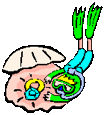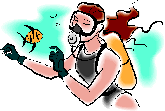Marine Protected Areas
The Pearls of Our Islands
Imagine traveling in an underwater paradise with six miles of caves and tunnels to explore, and strange and new animals everywhere. First, you swim along with a school of fish, discovering the mysteries of the 4th largest coral reef in the world. Afterwards, you walk along a stretch of golden beach where green turtles are found building nests for their eggs. Where are you? The Bahamas of course! You just visited the Lucayan, Andros and Exuma national parks, just a few of the treasured pearls of our islands!
The Bahamas National Park system is made up of twenty-five (25) protected areas. Some of the most special and rare of our Bahamian animals, such as the Bahama parrot and the endangered green sea turtle live within these parks. Many of our national parks include sections that can be called "Marine Protected Areas" or MPA's. An MPA is a general term that describes a part of the ocean that has been set aside by law in order to protect it from human impacts. They are most effective if they are "no-take" or reserve areas where you cannot go fishing or take anything out of them.
 Marine Protected Areas help the creatures that live inside them, but they also help us. Without them, fish won't have a safe place to get big and healthy and make lots of little fish. Fishermen won't be able to keep going out to sea and always catching fish for us to eat. Tourists won't travel thousands of miles to see the healthy reefs and wildlife in our country. As the "Pearls of Our Islands," our Marine Protected Areas are important to the overall health of our reefs, fisheries and the Bahamian way of life.
Marine Protected Areas help the creatures that live inside them, but they also help us. Without them, fish won't have a safe place to get big and healthy and make lots of little fish. Fishermen won't be able to keep going out to sea and always catching fish for us to eat. Tourists won't travel thousands of miles to see the healthy reefs and wildlife in our country. As the "Pearls of Our Islands," our Marine Protected Areas are important to the overall health of our reefs, fisheries and the Bahamian way of life.
Global stocks of large fish have declined by 90% in the past 50 years. Fishermen will tell you that there are not as many fish in the ocean now as when they were your age. MPAs are an important tool to help slow this decline and make sure that we and our children and grandchildren will have fish to eat. Although you are not allowed to go fishing inside these Marine Protected Areas, we now know that setting up MPAs is one of the best ways of making sure that we will have lots of fish to catch in the future.
 Many of the marine reserves contain nurseries, protected areas that are home to young sea animals where young fish and wildlife can be found. These shallow, flat mangrove areas allow them to grow up in a place where large predators cannot get to them. When they are big enough, they go out to reefs and the deep ocean to be with others of their kind. If nursery grounds are destroyed or if people are allowed to fish in them, soon there will be no safe place for young fish to grow into adult fish. By safeguarding these areas we protect future fish populations for us all.
Many of the marine reserves contain nurseries, protected areas that are home to young sea animals where young fish and wildlife can be found. These shallow, flat mangrove areas allow them to grow up in a place where large predators cannot get to them. When they are big enough, they go out to reefs and the deep ocean to be with others of their kind. If nursery grounds are destroyed or if people are allowed to fish in them, soon there will be no safe place for young fish to grow into adult fish. By safeguarding these areas we protect future fish populations for us all.
 Fish that grow up in our MPAs often swim across boundaries into areas where fishermen are able to catch them. The babies of many of the fish that we like to eat (like groupers, conch, snappers, crawfish) spend weeks or months floating in the water before they grow into big fish. Baby fish that come from MPAs will be carried by ocean currents and often grow up in fishing grounds where they can be caught by fishermen and eventually end up on your and my plate. Crawfish from the Exuma Park have been found breeding in areas as far away as 70 miles and grouper up to 150 miles! Fish, conch and crawfish that originated in the Exuma Land and Sea Park are caught by fishermen on islands as far away as Eleuthera, Cat Island and Long Island.
Fish that grow up in our MPAs often swim across boundaries into areas where fishermen are able to catch them. The babies of many of the fish that we like to eat (like groupers, conch, snappers, crawfish) spend weeks or months floating in the water before they grow into big fish. Baby fish that come from MPAs will be carried by ocean currents and often grow up in fishing grounds where they can be caught by fishermen and eventually end up on your and my plate. Crawfish from the Exuma Park have been found breeding in areas as far away as 70 miles and grouper up to 150 miles! Fish, conch and crawfish that originated in the Exuma Land and Sea Park are caught by fishermen on islands as far away as Eleuthera, Cat Island and Long Island.
Every fish on the reef or in our parks have a job to do.
 If they are not there, the whole community suffers. For example, certain animals like the crawfish and crab are the trash collectors of the reef. Others, like cleaner shrimp, are the doctors making sure that parasites do not infect the fish or the people who might eat the fish. At the base of it all are the corals which provide a home for sea creatures, protection from ocean waves and hurricanes, and even sand for our beaches. From the big to the small, the reef creatures depend on each other like citizens in modern city. By making sure we don't overfish any one member, we ensure that the whole reef community will stay healthy.
If they are not there, the whole community suffers. For example, certain animals like the crawfish and crab are the trash collectors of the reef. Others, like cleaner shrimp, are the doctors making sure that parasites do not infect the fish or the people who might eat the fish. At the base of it all are the corals which provide a home for sea creatures, protection from ocean waves and hurricanes, and even sand for our beaches. From the big to the small, the reef creatures depend on each other like citizens in modern city. By making sure we don't overfish any one member, we ensure that the whole reef community will stay healthy.
Marine Protected Areas give scientists a chance to study animals in a safe area.
At the Union Creek National Reserve in Inagua, scientists have studied the endangered Green sea turtle for the past 30 years, providing the world with some of the most important scientific data on this sea turtle. As much as scientists are doing, still only one percent of the ocean has been explored. It has been said that we know more about the surface of the moon than we know about the underwater world! Reefs serve as a living laboratory attracting scientists from all over the world who study and learn about the strange inhabitants of this wet-world.
The beauty and abundance of wildlife on our reefs attract millions of tourists to our country every year.
Through activities like scuba diving, snorkeling, boating and deep sea fishing tours many Bahamians make a good living. But the impact of a healthy reef system goes much further than just the water's edge. Each hotel worker, each restaurant owner, and each bus driver depend on those tourists to choose the Bahamas as their vacation destination. Without the reefs and the wildlife on them, many guests who come here would go someplace else, taking millions of dollars with them. If the visitors go, so will the jobs and the moneys they provide to our families.
Marine conservation is about taking action to protect our marine wildlife and the Ocean on which we all depend.
 Creating Marine Protected Areas in the Bahamas is the first step. The next step is your action. What can you do? Learn more about the wildlife that live in our parks. Express your concerns about the marine environment through Dolphin Encounter's annual poster competition. Get involved in a beach clean-up program to help prevent harmful trash from getting into the ocean. And if you are out enjoying time on the reefs, remind other boaters to drop their anchors clear of the reef and their trash in the trash can and to not fish in protected areas.
Creating Marine Protected Areas in the Bahamas is the first step. The next step is your action. What can you do? Learn more about the wildlife that live in our parks. Express your concerns about the marine environment through Dolphin Encounter's annual poster competition. Get involved in a beach clean-up program to help prevent harmful trash from getting into the ocean. And if you are out enjoying time on the reefs, remind other boaters to drop their anchors clear of the reef and their trash in the trash can and to not fish in protected areas.
Protecting our marine parks and our Bahamian ocean is important to make sure we survive.
 Keeping our waters full of wildlife will keep tourists in our country and fish in our bellies. Without Marine Protected Areas, our fisheries will be in danger. We can all help save our way of life by protecting the "pearls of our islands"... the Marine Protected Areas.
Keeping our waters full of wildlife will keep tourists in our country and fish in our bellies. Without Marine Protected Areas, our fisheries will be in danger. We can all help save our way of life by protecting the "pearls of our islands"... the Marine Protected Areas.
Marine Protected Areas in The Bahamas
Are Located in:
- Abaco
- Bimini
- Berry islands
- Central Andros
- Exuma Cays
- Inagua
- Moriah Harbour Cay
- New Providence
- Pelican Cay
- Peterson Cay
- South Eleuthera
- Tilloo Cay
- Walker’s Cay
Learn More about the Marine Protected Areas in The Bahamas by visiting www.BahamasNationalTrust.org.

